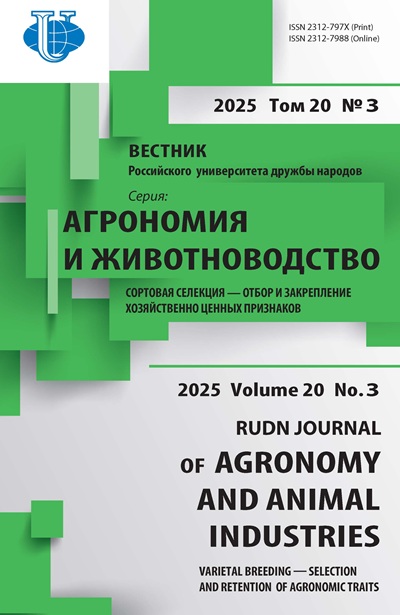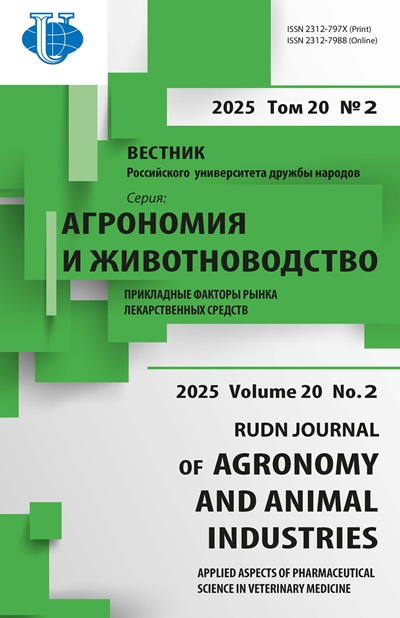Modern approaches to the prevention of actinobacillus pleuropneumonia in pigs
- Authors: Pimenov N.V.1, Shashkova A.A.1, Kruglov A.A.1
-
Affiliations:
- Moscow State Academy of Veterinary Medicine and Biotechnology - MVA named after K.I. Skryabin
- Issue: Vol 20, No 2 (2025): Applied aspects of pharmaceutical science in veterinary medicine
- Pages: 300-309
- Section: Veterinary science
- URL: https://agrojournal.rudn.ru/agronomy/article/view/20202
- DOI: https://doi.org/10.22363/2312-797X-2025-20-2-300-309
- EDN: https://elibrary.ru/NYGJOP
- ID: 20202
Cite item
Full Text
Abstract
Information about the current situation with actinobacillus pleuropneumonia (APP) in the Russian Federation is quite limited, which makes it difficult to assess the effectiveness of current preventive measures and develop new strategies. The diversity and effectiveness of vaccines play an important role. The main aim of the study is a scientific review of modern approaches to the APP prevention in pigs and prospects for the development of a vaccine that provides comprehensive protection against all known serotypes of this pathogen. The methods of systematization, critical analysis, and problem review are used. Over the years, various vaccines have been developed to combat this disease. Inactivated bacterial vaccines provide a strong immune response, but their effectiveness may vary. Based on the outer membrane proteins and three Apx toxoids, subunit vaccines are able to provide protection regardless of the APP serotype. DNA vaccines show promising results but require further research. Live attenuated vaccines contain weakened microorganisms and stimulate strong immunity, but their use also has its own difficulties. Despite all the successes achieved, at the moment there is no reliable and commercially profitable vaccine that would protect against all known serotypes of A . pleuropneumoniae and prevent the carriage and transmission of the disease. The problem of specific prevention of APP requires an integrated approach, including further scientific research, the development of new technologies and innovative methods of vaccination. Scientists increasingly focus on research in the field of oral and nasal vaccines. One of the important advantages is cost-effectiveness and safety during production, as well as convenience and safety of vaccine application. Oral and nasal vaccines can significantly simplify the immunization process, especially in the context of mass vaccination. Studies of vaccines based on external membrane vesicles and transgenic plants show promising results.
Full Text
Modern commercial vaccines against A. Pleuropneumoniae
Name, producer | Classification, status, composition | Antigenic composition | |
Serotype | Anatoxins | ||
VERRES-PGA VETBIOKHIM, LLC Russia | Inactivated, polyvalent, associated (H. parasuis, P. multocida) | 2, 5 | — |
Vaccine against actinobacillus pleuropneumonia in pigs FGBI «ARRIAH» Russia | Inactivated, polyvalent | 1, 6, 2, 3 | Apx I, Apx II, Apx III, OMP |
KOGLAPIX CEVA-PHYLAXIA Veterinary Biologicals Company Hungary | Inactivated, polyvalent | All | Apx I, Apx II, Apx III, OMP |
Aptovac Biowet Pulawy Sp. Z.o.o Poland | Inactivated, polyvalent, associated (P. multocida) | 2, 6 | — |
Porcilis APP INTERVET INTERNATIO NAL, B.V. Netherlands | Inactivated, polyvalent, subunit | All | Apx I, Apx II, Apx III, OMP |
NEUMOSUIN Laboratorios Hipra Spain | Inactivated, polyvalent | 2, 4, 5 | — |
RES-VAC Polyvalent inactivated vaccine against respiratory diseases in pigs JSC KOMIFARM Republic of Korea | Inactivated, polyvalent, associated (B. bronchiseptica, P. multocida, H. parasuis, M. hyopneumoniae) | 2, 5 | — |
Donoban‑10 KBNP, Inc. Republic of Korea | Inactivated, polyvalent, associated (B. bronchiseptica, P. multocida, M. hyopneumoniae, S. suis, H. parasuis) | 2, 5 | OMP |
Serkel Pleuro AP Dechra England | Inactivated, polyvalent | 1, 2, 3, 4, 5 | — |
Suvaxyn Respifed APP Zoetis Inc. USA | Inactivated, polyvalent | 1, 5, 7 | — |
Source: compiled by N.V. Pimenov, A.A. Kruglov based on [5, 6] and materials from: Federal State-Financed Institution "Federal Centre for Animal Health" (FGBI "ARRIAH"): official website. URL: https://www.arriah.ru (accessed: 12.15.2024); Seva Russia: official website. URL: https://www.ceva-russia.ru (accessed: 12.15.2024); NPK Pharmaindustria: official website. URL: https://pharmindustria.com (accessed: 12.16.2024); Vidal Drug Directory. URL: https://www.vidal.ru (accessed: 12.15.2024); Dechra: official website. URL: https://www.dechra.com.br/buscar (date of access: 12.17.2024); Zoetis: official website. URL: https://www2.ar.zoetis.com/ (date of access: 12.17.2024).
About the authors
Nikolay V. Pimenov
Moscow State Academy of Veterinary Medicine and Biotechnology - MVA named after K.I. Skryabin
Email: pimenov-nikolai@yandex.ru
ORCID iD: 0000-0003-1658-1949
SPIN-code: 1911-3815
Doctor of Biological Sciences, Professor, Head of the Department of Immunology and Biotechnology
23 Akademika Skryabina St., Moscow, 109472, Russian FederationAlexandra A. Shashkova
Moscow State Academy of Veterinary Medicine and Biotechnology - MVA named after K.I. Skryabin
Author for correspondence.
Email: aa.shashkova17@gmail.com
ORCID iD: 0009-0002-9434-675X
student
23 Akademika Skryabina St., Moscow, 109472, Russian FederationAlexander A. Kruglov
Moscow State Academy of Veterinary Medicine and Biotechnology - MVA named after K.I. Skryabin
Email: kruglovaa@biocombinat.ru
PhD student of the Department of Immunology and Biotechnology 23 Akademika Skryabina St., Moscow, 109472, Russian Federation
References
- Lebedev IG, Pimenov NV, Lomskov MA. Domestikatsiya zhivotnykh — biologicheskaya transformatsiya i ee nozologicheskie posledstviya domestikatsiya zhivotnykh [Animal domestication — biological transformation and its nosological consequences: The monograph.] Moscow: K.I. Scriabin Moscow State Pedagogical University. 2020; 256. (In Russ.).
- Sassu E, Bossé J, Tobias T, Gottschalk M, Langford P, Hennig-Pauka I. In vivo testing of novel vaccine prototypes against Actinobacillus pleuropneumoniae. Veterinary Research. 2018;49(1):4. doi: 10.1186/s13567-017-0502-x EDN: WMJBVH
- Kruglov AA, Royenko AD, Pimenov NV. Comparative assessment of the accumulation of microorganisms of Actinobacillus pleuropneumoniae on nutrient media of domestic and imported production for the production of vaccines against actinobacillus pleuropneumonia in pigs. The Veterinarian. 2024;(6):70–74. (In Russ.). doi: 10.33632/1998-698Х_2024_6_70 EDN: HMCCOJ
- Yevgrafova VA, Pruntova OV, Shadrova NB, Timina AM. Properties of Actinobacillus pleuropneumoniae isolates. Veterinary Science Today. 2023;12(2):178–184. (In Russ.). doi: 10.29326/2304-196X-2023-12-2-178-184 EDN: PFRAUI
- Pruglo VV. Vaktsinoprofilaktika aktinobatsilleznoi plevropnevmonii svinei [Vaccinoprophylaxis of actinobacillus pleuropneumonia in pigs]. Pigbreeding. 2011;(1):63. (In Russ.).
- Loera-Muro A, Angulo C. New trends in innovative vaccine development against Actinobacillus pleuropneumoniae. Veterinary Microbiology. 2018;217:66–75. doi: 10.1016/j.vetmic.2018.02.028
- Jinlin L, Xia C, Liwen L, Chen T, Yan C, Yi G, Meilin J, Aizhen G, Weicheng B, Huanchun C. Potential use an Actinobacillus pleuropneumoniae double mutant strain DeltaapxIICDeltaapxIVA as live vaccine that allows serological differentiation between vaccinated and infected animals. Vaccine. 2007;25(44);7696–7705. doi: 10.1016/j.vaccine.2007.07.053
- Chiang CH, Huang WF, Huang LP, Lin SF, Yang WJ. Immunogenicity and protective efficacy of ApxIA and ApxIIA DNA vaccine against Actinobacillus pleuropneumoniae lethal challenge in murine model. Vaccine. 2009;27(34):4565–4570. doi: 10.1016/j.vaccine.2009.05.058
- Bravo de Laguna F, Cabrera C, Belén González A, de Pascual C, José Pallarés F, Chevaux E, Castex M, Saornil D, Lebreton P, Ramis G. Effect of Feeding Saccharomyces cerevisiae boulardii CNCM I‑1079 to Sows and Piglets on Piglets’ Immune Response after Vaccination against Actinobacillus pleuropneumoniae. Animals (Basel). 2022;12(19):2513. doi: 10.3390/ani12192513 EDN: HDZRVK
- Kim MY, Kim TG, Yang MS. Production and immunogenicity of Actinobacillus pleuropneumoniae ApxIIA protein in transgenic rice callus. Protein Expression and Purification. 2017;132:116–123. doi: 10.1016/j.pep.2016.05.010
- Tiwari S, Verma PC, Singh PK, Tuli R. Plants as bioreactors for the production of vaccine antigens. Biotechnology Advances. 2009;27(4):449–467. doi: 10.1016/j.biotechadv.2009.03.006 EDN: LFZBUW
- Guan ZJ, Guo B, Huo YL, Guan ZP, Dai JK, Wei YH. Recent advances and safety issues of transgenic plant-derived vaccines. Applied Microbiology and Biotechnology. 2013;97(7):2817–2840. doi: 10.1007/s00253-012-4566-2 EDN: RJPBED
- Antenucci F, Fougeroux C, Deeney AS, Ørskov C, Rycroft A, Holst PJ, Bojesen AM. In vivo testing of novel vaccine prototypes against Actinobacillus pleuropneumoniae. Veterinary Research. 2018;49(1):4. doi: 10.1186/s13567-017-0502-x EDN: WMJBVH
- Cuccato M, Divari S, Ciaramita S, Sereno A, Campelli D, Biolatti P, Biolatti B, Meliota F, Bollo E, Cannizzo F. Actinobacillus pleuropneumoniae Serotypes by Multiplex PCR Identification and Evaluation of Lung Lesions in Pigs from Piedmont (Italy) Farms. Animals (Basel). 2024;14(15):2255. doi: 10.3390/ani14152255 EDN: QFYNPR
- Potekhin AV, Rusaleev VS. Monitoring of antibiotic resistance of Actinobacillus pleuropneumoniae isolated in the Russian Federation in 2012–2014. Veterinary Science Today. 2016;(1):24–29. (In Russ.).
- Bossé JT, Janson H., Sheehan BJ, Beddek AJ, Rycroft AN, Kroll JS, Langford PR. Actinobacillus pleuropneumoniae: pathobiology and pathogenesis of infection. Microbes and Infection. 2002;4(2):225–235. doi: 10.1016/s1286-4579(01)01534-9
Supplementary files















